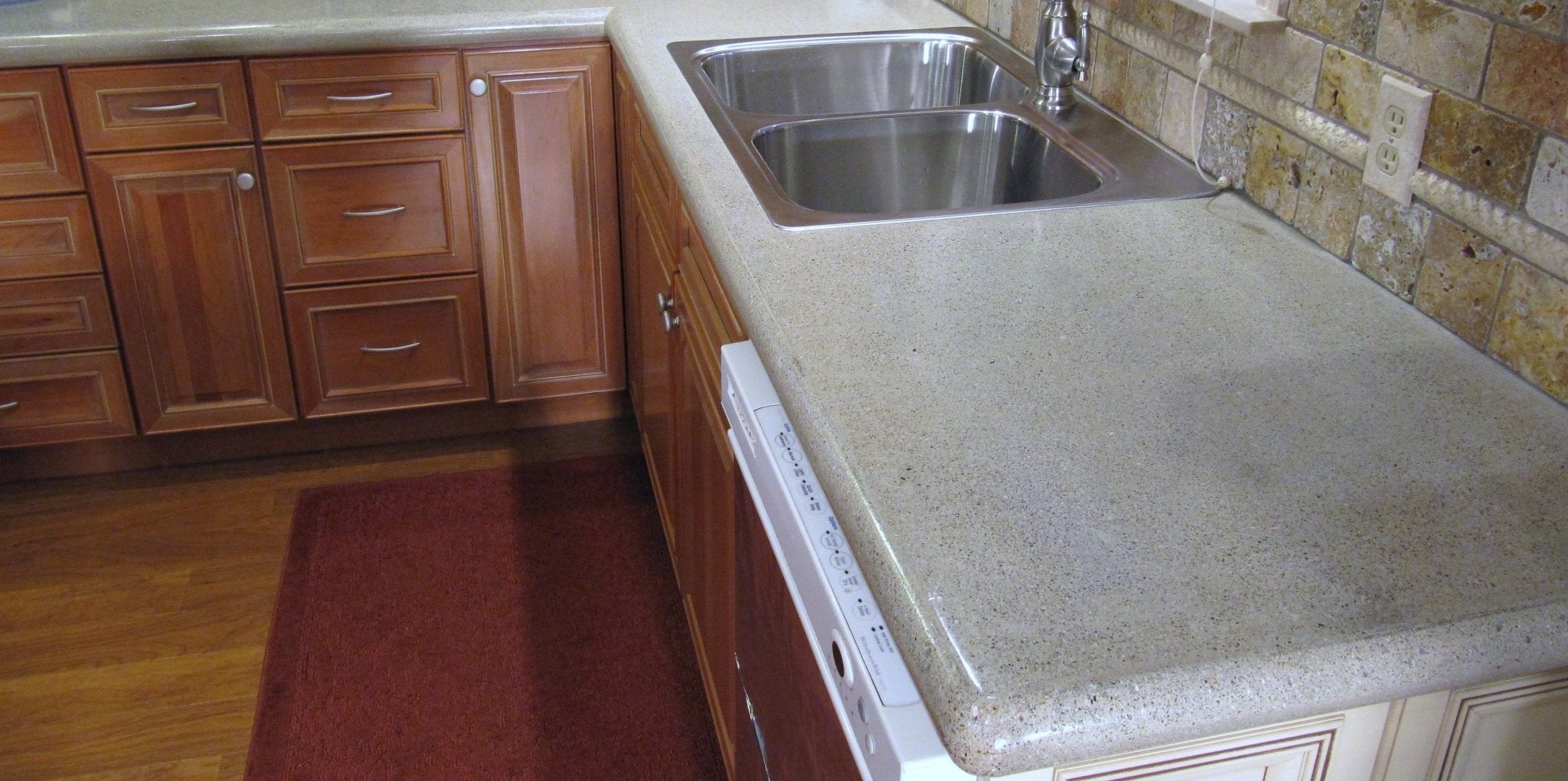Exposing Aggregate in Concrete Countertops
In the example above, no larger decorative aggregate was added but by wet polsihing the concrete, all of the sand and smaller aggregate in the concrete mix was exposed. Here you are looking at our Liqui-Crete additive with Sand/Topping Mix which has no large stone aggregate.
Exposed aggregate is a type of concrete finish that removes a thin top layer of cement cream to reveal aggregate material, so it’s visible on the surface. Very unique concrete countertops, bathroom vanities, sidewalks, walkways, driveways and pool decks have been created by exposing the sand and/or stone within the concrete or by adding some form of decorative aggregate. Often, this is in the form of stone, crushed glass or shells, but anything can be placed into the concrete that reflects your aesthetic. It’s becoming quite popular in concrete countertops whether indoors or out. Exposed aggregate creates interest and adds pizazz to a concrete countertop, or any concrete, for that matter.
There are a few ways that aggregate can be added to the countertop. You can mix it into the concrete while blending or you can seed it into the surface after the concrete is screeded, but before its floated. Also, a combination of both techniques may work best in some cases. If pre-casting the concrete upside down, the aggregate must either be added into the concrete or placed into the mold before pouring the concrete instead of seeding.
Each way has its pros and cons. If cost is not an issue, then mixing it into the concrete would be easiest. This will give you a uniform distribution of aggregate in regard to spacing, but it will also use more material. Seeding it into the surface uses less material and allows you to place it in specific areas if you want to create certain patterns or designs. If pre- casting the top, and wanting a specific design, you can glue the 35ceaggregate to the bottom of the mold so it stays in place when the concrete is poured. This method also uses much less material. The type and size of aggregate you choose should be taken into consideration based on your project as workability and strength will come into play.
A variety of things can be embedded from sea shells to fossils, coins to leaves and logos, even fiber optics and glow in the dark aggregate. The possibilities are endless when it comes to creating unique and dramatic finishes with exposed aggregate.

Here decorative stone was seeded into the surface of the concrete to create a unique pattern of high and low stone concentration.

Here our White Countertop Mix was used and seeded with some clear glass. When polished you see the sand and marble dust from the concrete mix as well as some of the larger glass that was added.

In this photo our White Countertop Mix was used but both decorative glass and charcoal inetgral color was added to the concrete. When polished, the glass as well as the small white sand in the concrete became exposed.
After the concrete is poured and finished, there are a few methods that can be used to expose the aggregate, such as water washing, abrasive blasting, honing and acid etching, but when it comes to concrete countertops, whether pre-cast or poured in place, a Wet Polisher and Diamond Polishing Pads are most common. This process will expose the top of the stone/aggregate leaving the rest embedded in the concrete. The Diamond Polishing Pads are attached to the Wet Polisher starting with a courser grit, usually 50, to remove the top layer. You will continue to work your way up until you have reached your desired surface finish. Polishing with finer grits ranging from 400-3000 will give you a glossy, polished look that not only shines, but shows off your aggregate. If wet polishing is not possible, dry polishing pads can be used to achieve the same look without the mess. You must have a smooth troweled surface first when dry sanding. If the top is rough or gritty its best to start with wet polishing pad or even a diamond cup wheel before attempting to dry polish. This is the same for exposing large or very deep aggregate - its best to wet sand instead of dry sand.
Regardless of which process you take, the look of a concrete countertop showing exposed aggregate will not only be original and functional but will stand out with guests and surely be a conversational piece with each person visiting your home for years to come.
Written by:

